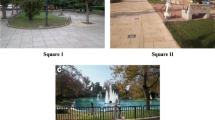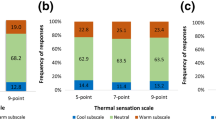Abstract
The main objective of the present quasi-experimental study was to examine the influence of culture (Swedish vs Japanese) and environmental attitude (urban vs open-air person) on participants’ thermal, emotional and perceptual assessments of a square, within the PET (physiological equivalent temperature) comfortable interval of 18–23°C. It was predicted that persons living in different cultures with different environmental attitudes would psychologically evaluate a square differently despite similar thermal conditions. Consistent with this prediction, Japanese participants estimated the current weather as warmer than did Swedish participants and, consistent with this, they felt less thermally comfortable on the site, although participants in both countries perceived similar comfortable thermal outdoor conditions according to the PET index. Compared to the Japanese, the Swedes estimated both the current weather and the site as windier and colder, indicating a consistency in weather assessment on calm-windy and warm-cold scales in participants in both cultures. Furthermore, Swedish participants felt more glad and calm on the site and, in line with their character (more glad than gloomy), they estimated the square as more beautiful and pleasant than did Japanese participants. All this indicates that thermal, emotional and perceptual assessments of a physical place may be intertwined with psychological schema-based and socio-cultural processes, rather than fixed by general thermal indices developed in line with physiological heat balance models. In consequence, this implies that thermal comfort indices may not be applicable in different cultural/climate zones without modifications, and that they may not be appropriate if we do not take into account the psychological processes involved in environmental assessment.














Similar content being viewed by others
References
Bartlett FC (1932) Remembering. Cambridge University Press, Cambridge
Brewer WF, Treyens JC (1981) Role of schemata in memory for places. Cognit Psychol 13:207–230
Cousins SD (1989) Culture and self-perception in Japan and the United States. J Pers Soc Psychol 1:124–131
Eagly AH, Chaiken S (1993) The psychology of attitudes. Harcourt Brace College, New York
Eisler AD, Eisler H, Yoshida M (2003) Perception of human ecology: cross-cultural and gender comparisons. J Environ Psychol 23:89–101
Fanger PO (1970) Thermal comfort. Danish Technical Press, Copenhagen
Forwood B, Hayman S, Tadepalli S (2001) Thermal comfort in urban open spaces. In: de Dear RJ, Potter JC (eds) Biometeorology and urban climatology at the turn of the millennium. Proceedings of the International Congress of Biometeorology and International Conference of Urban Climatology, 8– 12 November 1999. Wesley Conference Centre, Sydney
Franck AK (2002) Women and environment. In: Bechtel RB, Churchman A (eds) Handbook of environmental psychology. Wiley, New York, pp 347–373
Gagge AP (1980) The new effective temperature (ET*)—and index of human adaption to warm environments. In: Horvath, Yousef (eds) Environmental physiology: aging, heat and altitude. Elsevier, Amsterdam, pp 59–77
Gates DM (1972) Man and his environments: climate. Harper and Row, New York
Gehl J (1968) Mennesker til fods (in Danish). Arkitekten 70(20):429–446
Gehl J (1996) Life between buildings, using public spaces. Ariktekt Forlag 173–201
Gifford R (1980) Environmental dispositions and the evaluation of architectural interiors. J Res Pers 14:386–399
Gonzales RR, Nishi Y, Gagge AP (1974) Experimental evaluation of standard effective temperature a new biometeorological index of man’s thermal discomfort. Int J Biometeorol 18:1–15
Harley T (2003) Nice weather for the time of year: the British obsession with the weather. In: Strauss S, Orlove B (eds) Weather, climate, culture. Berg, Oxford, pp 103–118
Höppe (1984) Die Energiebilanz des Menschen Dissertation. University of Munich, Munich
Höppe P (1993) Heat balance modelling. Experientia 49:741–746
Höppe P (1997) Aspects of human biometeorology in past, present and future. Int J Biometeorol 40:19–23
Höppe P (2002) Different aspects of assessing indoor and outdoor thermal comfort. Energy Build 34:661–665
Jendritzky G, Sönning W, Swantes HJ (1979) Ein objectives Bewertungsverfahren zur Beschreibung des hermischen Milieus in der Stadt- und Landschaftsplanung. Beiträge Akademie für Ramforschung und Landesplanung, Beiträge 28. Schrödel, Hannover
Ji L-J, Zhang Z, Nisbett RE (2004) Is it culture or is it language? Examination of language effects in cross-cultural research on categorization. J Pers Soc Psychol 1:57–65
Kitayama S, Markus HR, Matsumoto H, Norasakkunkit V (1997) Individual and collective processes in the construction of the self: self-enhancement in the United States and self-criticism in Japan. J Pers Soc Psychol 6:1245–1267
Kitayama S, Snibbe AC, Markus HR, Suzuki T (2004) Is there any “free” choice? Self and dissonance in two cultures. Psycol Sci 8:527–533
Knez I (2005) Attachment and identity as related to a place and its perceived climate. J Environ Psychol 25:207–218
Knez I, Hygge S (2001) The circumplex structure of affect: a Swedish version. Scand J Psychol 42:389–398
Lawton MP, Windley P, Byerts T (eds) (1982) Aging and the environment; theoretical approaches. Springer, New York Berlin Heidelberg
Li S (1994) Users’ behaviour of mall urban spaces in winter and margin seasons. Archit Comport/Arch Behav 10:95–109
Liebert RM, Liebert LL (1995) Science and behavior: anintroduction to methods of psychological research. Prentice Hall, New York
Markus HR, Kitayama S (1991) Culture and self: implications for cognition, emotion amd motivation. Psychol Rev 2:224–253
Matzarakis A (2002) Validation of modelled mean radiant temperature within urban structures. In: AMS, Fourth Symposium on the Urban Environment, 20–24 May 2002, Norfolk, Virginia Abs 7.3, 72–73
Matzarakis A, Mayer H (1996) Another kind of environmental stress: thermal stress. WHO Newslett 18:7–10
Matzarakis A, Rutz F, Mayer H (2000) Estimation and calculation of the mean radiant temperature within urban structures. In: de Dear RJ, Kalma JD, Oke TR, Auliciems A (eds) Biometeorology and urban climatology at the turn of the millennium. Selected Papers from the Conference ICB-ICUC’99, Sydney, WCASP-50, WMO/TD No 1026, pp 273–278
Mayer H, Höppe P (1987) Thermal comfort of man in different urban environments. Theor Appl Climatol 38:43–49
McGuigan FJ (1983) Experimental psychology: methods of research. Prentice Hall, NewJersey
Minsky M (1975) A framework for representing knowledge. In: Winston PH (ed) The psychology of computer vision. McGraw-Hill, New York
Nagara K, Shimoda Y, Mizuno M (1996) Evaluation of the thermal environment in an outdoor pedestrian space. Atmos Environ 30:497–505
Nasar JL, Yurdakul AR (1990) Patterns of behaviour in urban public spaces. J Archit Plann Res 7:71–85
Nikolopoulou M, Steemers K (2003) Thermal comfort and psychological adaptation as a guide for design urban spaces. Energy Build 35:95–101
Nikolopoulou M, Baker N, Steemers K (2001) Thermal comfort in outdoor urban spaces: understanding the human parameter. Sol Energy 70:227–235
Piaget J, Inhelder B (1973) Memory and intelligence. Basic Books, New York
Reber AS (1985) Dictionary of psychology. Penguin Books, New York
Spagnolo J, de Dear R (2003) A field study of the thermal comfort in outdoor and semi-outdoor environments in subtropical Sydney Australia. Build Environ 38:721–738
Stehr N, von Storch H (1995) The social construct of climate and climate change. Clim Res 5:99–105
Steadman RG (1971) Indices of windchill of clothed persons. J Appl Meteorol 10:674–683
Steadman RG (1979) The assessment of sultriness. Part I. A temperature-humidity index based on human physiology and clothing science. J Appl Meteorol 18:861–873
Sternberg RJ (2004) Culture and intelligence. Am Psychol 5:325–338
Stull R (2000) Meteorology for scientists and engineers. Pacific Grove, Brooks/Cole
Thom TC (1959) The discomfort index. Weatherwise 12:57–60
Thorsson S (2003) Climate, air quality and thermal comfort in the urban environment. Doctoral thesis A87, available from Earth Science Centre, Göteborg University, Box 460, 405 30 Göteborg, Sweden
Thorsson S, Lindqvist M, Lindqvist S (2004) Thermal bioclimatic conditions and patterns of behaviour in an urban park in Göteborg, Sweden. Int J Biometeorol 48:149–156
VDI (1994) VDI 3787, Part 2: environmental meteorology, interactions between atmosphere and surfaces; calculation of the short- and long wave radiation. VDI/DIN- Handbuch Reinhaltung der Luft, Band 1b, Düsseldorf
VDI (1998) VDI 3789, Part I: environmental meteorology, methods for the human biometeorological evaluation of climate and air quality for the urban and regional planning at regional level. Part I: climate. VDI/DIN- Handbuch Reinhaltung der Luft, Band 1b, Düsseldorf
Wang Q (2004) The emergence of cultural self-constructs: autobiographical memory and self-description in European, American and Chinese children. Dev Psychol 1:3–15
Zacharias J, Stathopoulos T, Hanqing W (2001) Microclimate and downtown open space activity. Environ Behav 33:296–315
Acknowledgements
This work was supported by a research grant from FORMAS, the Swedish Research Council for Environment, Agricultural Sciences and Spatial Planning, and from the Japan Society for Promotion of Science (JSPS) Postdoctoral Fellowship for North American and European Researchers. The field surveys in Matsudo, Japan were performed in collaboration with Professor Tsuyoshi Honjo and Dr. En-Mi Lim at the Graduate School of Science and Technology, Chiba University, Japan. We would like to thank the Urban Climate Spaces research group and Terry Hartig for constructive comments.
Author information
Authors and Affiliations
Corresponding author
Rights and permissions
About this article
Cite this article
Knez, I., Thorsson, S. Influences of culture and environmental attitude on thermal, emotional and perceptual evaluations of a public square. Int J Biometeorol 50, 258–268 (2006). https://doi.org/10.1007/s00484-006-0024-0
Received:
Revised:
Accepted:
Published:
Issue Date:
DOI: https://doi.org/10.1007/s00484-006-0024-0




